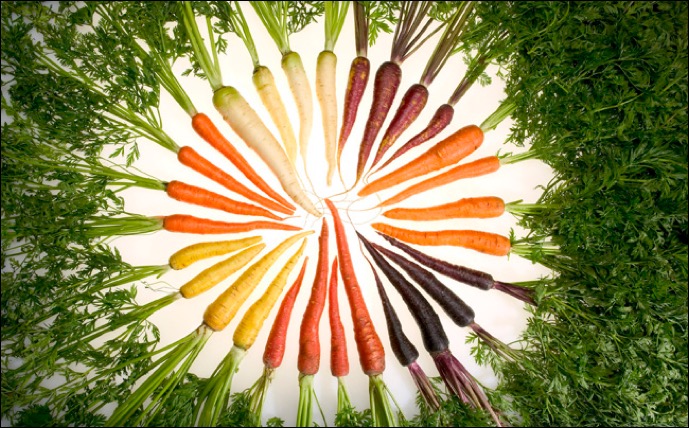Madison, Wisconsin, USA
May 9, 2016

Carrots derive their color from pigment compounds called carotenoids. Orange carrots are colored by alpha- and beta-carotene, while red carrots get their color from lycopene, yellow from lutein and purple from anthocyanin. These pigments also provide the nutrition found in carrots. Photo courtesy of Phil Simon, UW–Madison, USDA-ARS
Sometimes, the evolutionary history of a species can be found in a fossil record. Other times, rocks and imprints must be swapped for DNA and genetic fingerprints.
 The latter is the case for the good-for-your-eyes carrot, a top crop whose full genetic code was just deciphered by a team of researchers led by University of Wisconsin–Madison horticulture professor and geneticist Phil Simon (picture). Simon is also a research scientist with the U.S. Department of Agriculture’s Agricultural Research Service, which helped fund the work. The study is published today in the journal Nature Genetics.
The latter is the case for the good-for-your-eyes carrot, a top crop whose full genetic code was just deciphered by a team of researchers led by University of Wisconsin–Madison horticulture professor and geneticist Phil Simon (picture). Simon is also a research scientist with the U.S. Department of Agriculture’s Agricultural Research Service, which helped fund the work. The study is published today in the journal Nature Genetics.
It tells a story of how the carrot has been touched by domestication and breeding practices and influenced by environmental and geologic change, and it fills in a family tree of relatives that otherwise appear distinct. It also reveals how carrots have become so good at accumulating carotenoids, the pigment compounds that give them their characteristic colors and provide them with their nutritional strength.
“The carrot has a good reputation as a crop and we know it’s a significant source of nutrition — vitamin A, in particular,” Simon says. “Now, we have the chance to dig deeper and it’s a nice addition to the toolbox for improving the crop.”
The knowledge gained from the study could also lead to the improvement of similar crops, from parsnip to the yellow-fleshed cassava, a staple food throughout much of Africa.
“This was an important public-private project, and the genomic information has already been made available to assist in improving carrot traits such as enhanced levels of beta-carotene, drought tolerance and disease resistance,” says co-author Allen Van Deynze, director of research at the University of California, Davis’ Seed Biotechnology Center. “Going forward, the genome will serve as the basis for molecular breeding of the carrot.”
Carrots have a long history as a domesticated root crop. The first cultivated carrots appeared 1,100 years ago in Central Asia. These carrots were — unlike their white wild ancestors — purple and yellow. The canonical orange carrot appeared later, in Europe in the 1500s, providing at the time an aesthetic subject for German and Spanish art. Even before domestication, wild carrot seeds showed up in 3,000- to 5,000-year-old primitive campsites in Germany and Switzerland.

Carrots are the richest crop source of vitamin A in the American diet. Vitamin A is an essential nutrient. Photo courtesy of Phil Simon, UW–Madison, USDA-ARS
The study cannot answer why the first crops were purple and yellow, though it can verify that it is not because of flavor. The genes for color and the genes associated with preferred flavors are not connected. But that colored carrots became popular is fortuitous: The pigments are what make them nutritious, and orange carrots are the most nutritious of all, Simon says. Carrots are the richest crop source of vitamin A in the American diet.
The new study reveals how that orange color happens. “The accumulation of orange pigments is an accumulation that normally wouldn’t happen,” says Simon, one of just a few carrot researchers around the world, along with another UW–Madison scientist, Irwin Goldman, who was not part of this study. “Now, we know what the genes are and what they do.”
The research team used the Nantes carrot — a bright orange form of the vegetable named for a city in France — to assemble and analyze the full genetic sequence, peering into the machinery that drove the carrot’s evolution, and the bread crumbs left through time.
The carrot genome contains more than 32,000 genes arranged among nine chromosomes, which code for pest and disease resistance, colorful carotenoids and more. Carotenoids, like alpha- and beta-carotene, were first discovered in carrots.
The researchers uncovered features traced to distantly related plant species, from grapes and tomatoes to kiwis and potatoes. Carrots more recently split from lettuce and they are in the same family as spice crops, like parsley and fennel.
The researchers also sequenced 35 different types of carrots to compare them to their wild ancestors. They showed carrots were first domesticated in the Middle East and Central Asia, confirming the Vavilov Center of Diversity theory, which predicts cultivated plants arose from specific regions rather than randomly.
They also learned that sometime between the Cretaceous and Paleogene periods — roughly around the time dinosaurs went extinct — carrots picked up genetic advantages common to other plants of the era that allowed them to thrive.
Additionally, the study confirmed a gene called Y is responsible for the difference between white carrots and yellow or orange ones, and that a variation of it leads to the accumulation of carotenoids.
But it also identified a new, previously unknown gene that contributes to the accumulation of the colorful compounds. Both genes are recessive, which means two copies of each are needed for carotenoids to build up in the plant, which is actually a defect in a metabolic pathway that appears to be related to light-sensing.
Plants derive their own nutrition through light-sensing, or photosynthesis, but roots like carrots aren’t normally exposed to light and do not need photosynthetic pigments like carotenoids. “It’s a repurposing of genes plants usually use when growing in light,” says Simon.
It appears these genes were inadvertently selected for by early growers, and Simon suggests it may have simply been to aid early domesticators — likely to have been women — differentiate between wild carrots and the plants they intended to grow.
“They could keep their crops ‘clean’ from a patch of wild carrots growing 50 meters away by choosing only the purple or yellow ones,” says Simon, who jokes: “Or maybe it was the food fad of the 10th century, with orange in the 16th.”
Global carrot consumption quadrupled between 1976 and 2013 and over the last 40 years, breeding has led to more nutritious carrots with the selection of ever more intensely orange crops. In fact, carrots have 50 percent more carotene today than they did in 1970.
While most Americans are not deficient in vitamin A, it is considered an essential nutrient and deficiency is a problem in some U.S. communities and around the world. While the study may not solve the problem, it does highlight the opportunity carrots present to improve health and economic outcomes in other nations.
“Globally, we hand out vitamin A capsules, but why not have people grow their own?” Simon asks. “In one square meter you can grow a single crop of carrots per year to feed up to a half dozen adults. You can grow half now and half in six months to give you a sustainable source of vitamin A and a valuable crop in the marketplace.”
The study also reflects a shift in how plant breeders operate, by taking advantage of new technologies to answer basic questions about cultivated crops.
“It tells us things about the genome we expected but didn’t know before,” says Simon. “Each crop has a story to tell.”
The study also includes co-authors from Michigan State University and around the world, including Poland, Spain, Italy, Turkey, China and Argentina. It was funded by several seed companies and the carrot industry, as well as the National Science Foundation, the Polish National Science Center and the Polish Ministry of Science and Higher Education. The authors declare no competing financial interests and Simon explains that industry funds make the work possible.
Sometimes, the evolutionary history of a species can be found in a fossil record. Other times, rocks and imprints must be swapped for DNA and genetic fingerprints.
The latter is the case for the good-for-your-eyes carrot, a top crop whose full genetic code was just deciphered by a team of researchers led by University of Wisconsin–Madison horticulture professor and geneticist Phil Simon. Simon is also a research scientist with the U.S. Department of Agriculture’s Agricultural Research Service, which helped fund the work. The study is published today in the journal Nature Genetics.
It tells a story of how the carrot has been touched by domestication and breeding practices and influenced by environmental and geologic change, and it fills in a family tree of relatives that otherwise appear distinct. It also reveals how carrots have become so good at accumulating carotenoids, the pigment compounds that give them their characteristic colors and provide them with their nutritional strength.
- See more at: http://news.wisc.edu/carrot-genome-paints-picture-of-domestication-could-help-improve-crops/?utm_source=news-release&utm_medium=email&utm_campaign=news-release-short#sthash.xefvJLrs.dpuf